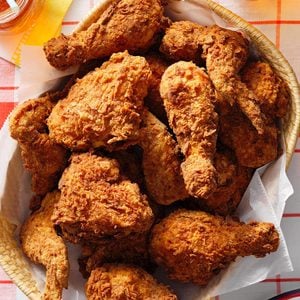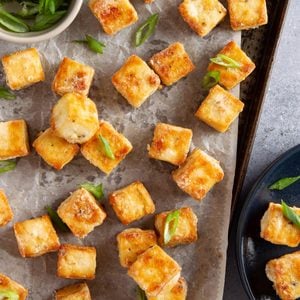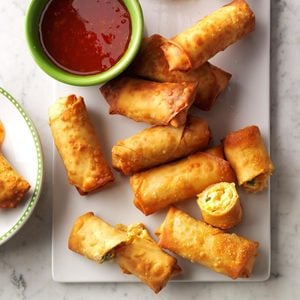What’s the Difference Between Crispy and Crunchy?
Updated: Apr. 21, 2024

It might seem finicky, but there is a real difference between crispy and crunchy. Here's our quick guide to crispy vs. crunchy foods, including tips for making the crispiest foods.
Both crispy foods and crunchy foods have a snap. They’re the opposite of soft, mild or yielding. Neither allows for a quiet bite: they crackle, they crunch, they snap. Crunchy and crispy foods keep you coming back for more: think of tasty snacks you just keep munching.
Still, there is absolutely a distinction between the adjectives—as much as they have in common, they are not synonyms.
The Difference Between Crispy vs. Crunchy
Crispy Foods
Crispy foods are lighter, thinner and more brittle. They’re more likely to be crackly or flaky when eaten. Crisp food shatters between teeth. To start with an obvious example: Rice Krispies are crisp (at least until they come into contact with milk). Their snap and crackle is light, almost effervescent.
Perfectly cooked fried chicken has crispy skin. In fact, most breaded and fried foods are crispy, from shrimp to vegetable tempura. The skinniest French fries are crispy, the sort that gather at the bottom of the packet, covered in salt, their ends sharp as toothpicks. Wafer cookies are crispy, snapping and then melting into the mouth. The browned edges of pastry crust are crispy. The caramelized cap of creme brulee is crispy, cracking at the tap of a spoon.
In Britain, chips are actually called “crisps,” and the name fits. Think of a thin Classic Lay’s potato chip, almost transparent when held to the light, crisply breaking between your teeth. (We actually taste-tested potato chips to find the crispiest.) Crispy foods tend to leave sharp, shard-like crumbs behind. On the other hand, hearty kettle-cooked chips are almost always crunchy…which leads us to our next definition.
Crunchy Foods
In brief, crunch is more muscular than crisp. While crispiness is almost always confined to the edges or outsides of foods, crunch is bold enough to carry all the way through. Crunch is loud, hard and tough. That’s why thicker kettle-cooked chips fall into the crunchy category rather than the crispy.
Other crunchy foods? Nuts are crunchy. Breadsticks are crunchy. Raw carrots are very crunchy. In fact, most raw vegetables and fruits are crunchy: apples, pears, celery, broccoli, cauliflower, snap peas, peppers.
Crunchy foods can be wet, while crisp foods tend to be dry. Think pickles, iceberg lettuce and cucumbers.
Lots of snack foods are crunchy too. Popcorn, trail mix, pumpkin seeds, crackers, wasabi peas and M&M’s all fall under the crunchy category. Sprinkles are crunchy. And Corn Nuts are dangerously crunchy.
Crunch lives on the edge. You might chip a tooth on a particularly hard crunch. But crunch is also straightforward and easy to achieve even in the home kitchen. Bake peanut butter cookies or biscotti until they’re entirely firm, and voilá: crunch. Fry corn torillas until brown and you’ve got crunchy chips. Toast bread crumbs until they’re golden and—crunch! It’s the crispy foods that are a bit trickier to master.
Tips for Making Crispy Food
Want to make perfectly crispy foods at home? Here are a few tricks:
- Wet is the enemy of crisp, so before you fry vegetables (cauliflower, potatoes) or meat, pat them dry.
- Coat foods in cornstarch before frying.
- Alternatively, dip foods into a batter before frying. Our favorite fried fish recipe uses this method.
- Don’t overcrowd food in the frying pan (or air fryer basket), which will make the temperature of the oil drop and the crisp go soggy.
- Try double-frying: fry food until the outside is just getting crisp, then remove to sit for a few minutes at room temperature before returning to the frying pan. After foods fry, moisture from the center of the food migrates to the surface, softening up the exterior—this method basically eliminates that process, yielding much crispier results.
- The longer fried foods sit out, the softer they get. Keep cooked food warm in a low oven until ready to eat, and know that leftovers will get a bit softer (though you can re-crisp them in a hot oven).






















